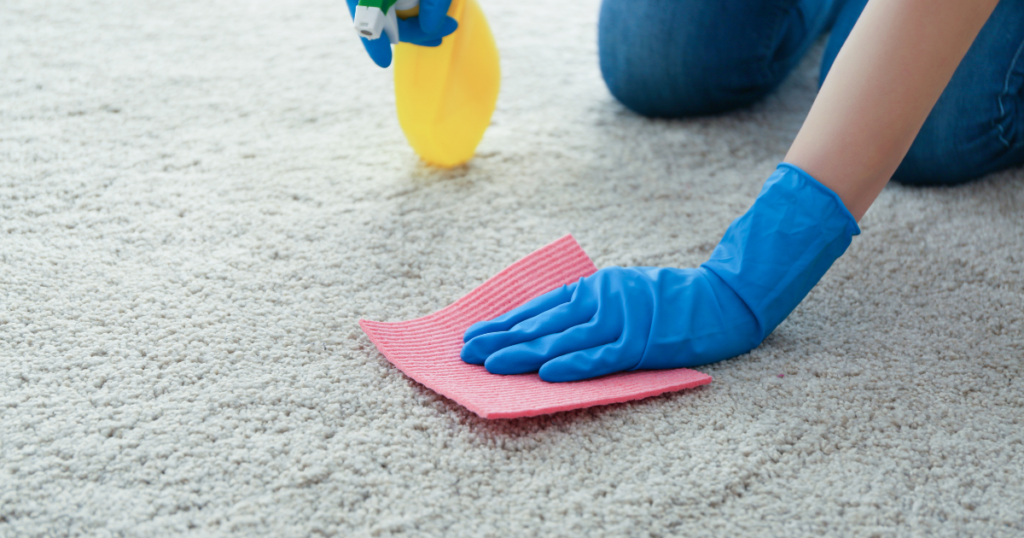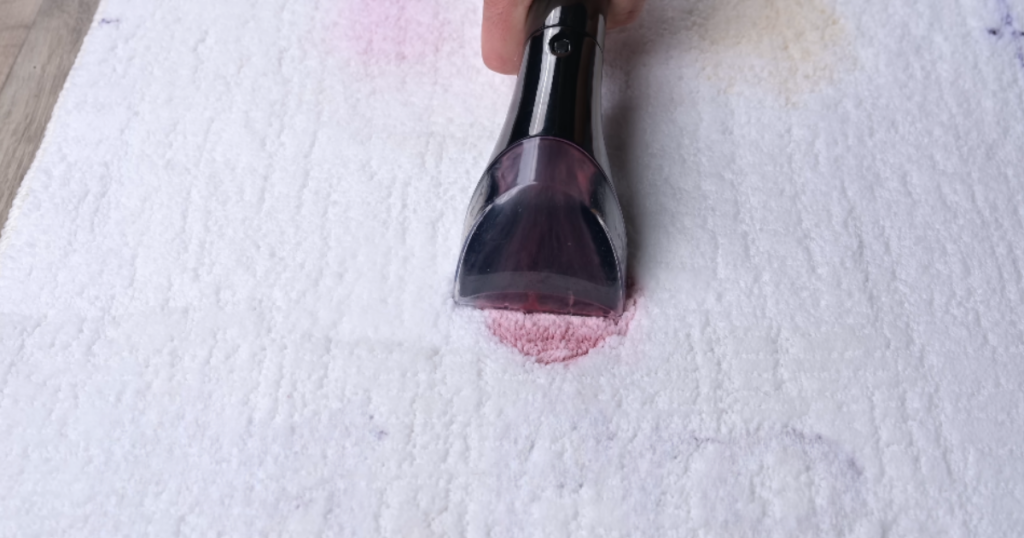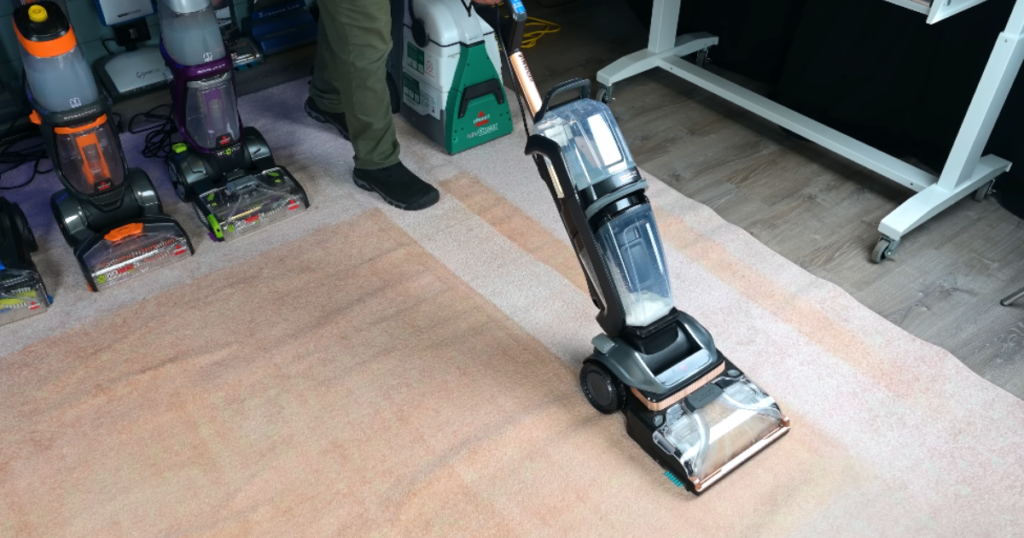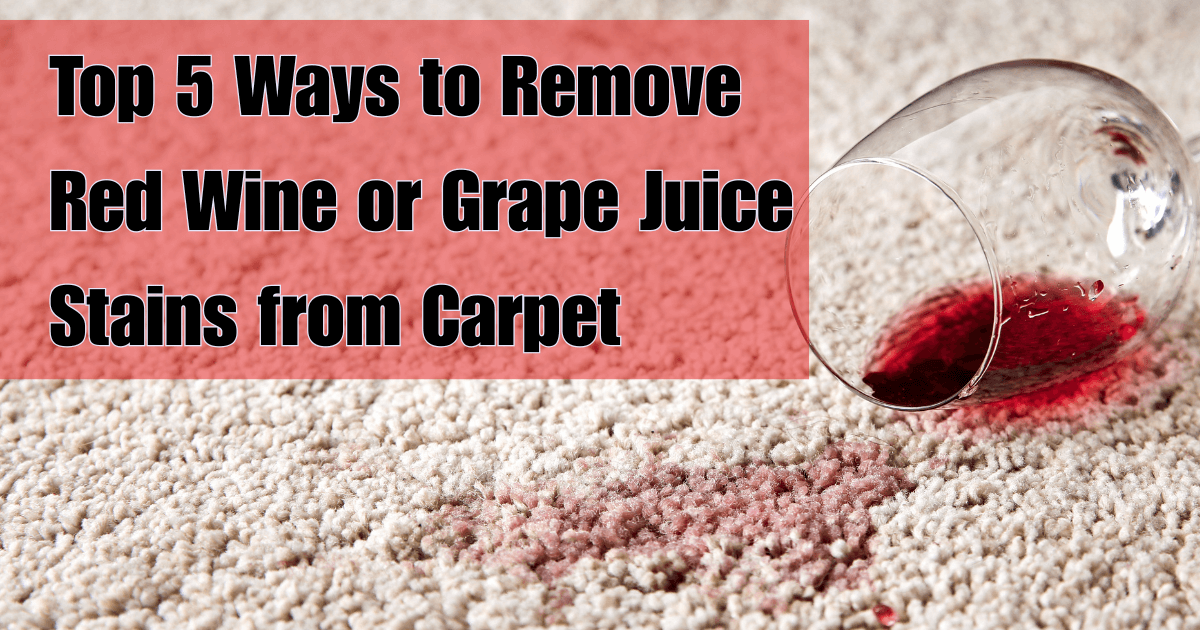Spilled Cabernet on the living room rug or knocked over a cup of grape juice? Don’t panic! Red wine and grape juice are infamous for leaving stubborn stains on carpets due to their dark pigments and tannins. The key is to act fast and use the right method. In this article, we’ve compiled five expert-backed ways to rescue your carpet, from quick DIY fixes to heavy-duty machine cleaning.
1. Blot Immediately and Use Club Soda
Club soda is a classic remedy provided that you are following the right steps and in the right order. According to Martha Stewart, when a red wine or grape juice spill happens, your first move should be quick blotting – not rubbing – to soak up as much liquid as possible. Rubbing can spread the stain and push it deeper into carpet fibers.
Once you’ve blotted up the excess, reach for some club soda. The carbonation in club soda helps dilute and break apart the wine’s red pigments, making them easier to lift out of the carpet. Continue the pour-and-blot cycle until you see no more red color transferring to your cloth. Patience is key – persistent blotting and fresh soda can gradually remove the stain.
If you’re dealing with a very heavy spill, some experts suggest sprinkling salt on the stain after blotting up the liquid. The salt can absorb remaining wine; let it sit for a few hours (or overnight), then vacuum up the salt crystals that have turned pink with the wine it soaked up [certifiedcleancare.com].
This club soda trick is a time-honored, consumer-friendly method that many swear by. It’s especially handy if you catch the spill while it’s fresh.

2. Dish Soap and White Vinegar Solution
If the stain persists or has started to set, turn to a simple DIY cleaning solution using items in your pantry. White vinegar and dish soap make a powerful combo for tackling wine or juice stains on carpet. Vinegar is acidic, which helps break up the dark tannins in red wine and grape juice, effectively neutralizing those red-purple pigments. Dish soap, meanwhile, aids in lifting and capturing the stain. Here’s how thespruce.com and some others describe this solution:
- Mix the solution: In a bowl or spray bottle, mix about 1 tablespoon of white vinegar, 1 tablespoon of liquid dish soap, and 2 cups of warm water. (You can also use a 1:1 ratio of vinegar and dish soap in warm water; Good Housekeeping recommends ½ teaspoon of each per 2 cups water for smaller spots [goodhousekeeping.com].) This gentle cleaner is suitable for most carpets – just avoid over-saturating the area.
- Blot and apply: Blot the stained area once more with a clean cloth to ensure no excess liquid remains. Then apply the vinegar-soap solution. You can lightly spray it on or dab it with a sponge or cloth. Work from the outside of the stain inward while blotting, so you’re not spreading the spot. The vinegar will start breaking down the wine’s color on contact.
- Gently agitate and blot: You might gently work the solution into the carpet with your fingers or a soft brush, but don’t scrub aggressively. Let it sit for a minute or two to penetrate the fibers. Then blot with a clean damp cloth. You should see the red stain transferring into your cloth as the solution does its job.
- Rinse and dry: It’s important not to leave any soapy residue in the carpet, as that can attract dirt later. Go over the area with a cloth moistened with plain cold water to “rinse” the carpet [goodhousekeeping.com]. Blot up the moisture until the carpet is as dry as possible. You can also lay a dry towel over the spot and weigh it down to absorb residual dampness [bhg.com].
This method is backed by cleaning experts and publications like Good Housekeeping, which note that a vinegar and dish soap mixture can conquer stubborn wine stains when used after initial blotting [goodhousekeeping.com]. It’s a cheap, all-natural remedy. Always remember to test any carpet solution on a hidden patch of carpet first, just to be safe with your carpet’s dye.
3. Hydrogen Peroxide and Dish Soap (Oxidizing Method)
For tough or dried red wine stains, an oxygen-based approach can work wonders. Hydrogen peroxide (H₂O₂) is essentially a mild bleach and oxidizer that can break down color compounds in stains. Many professional cleaners and guides (including Martha Stewart’s experts) recommend a mixture of hydrogen peroxide and dish soap to tackle persistent carpet stains from wine. This method is particularly effective on light-colored or synthetic carpets; be cautious on dark or natural-fiber rugs, as peroxide can lighten some materials.
- Test first: Because hydrogen peroxide has bleaching power, always test your peroxide solution on an inconspicuous corner of the carpet first to ensure it doesn’t cause discoloration [thespruce.com]. Most household hydrogen peroxide is 3% strength, which is safe for many fabrics, but it’s better to be certain.
- Mix the solution: Combine hydrogen peroxide and dish soap in a ratio of about 2:1 (for example, 2 tablespoons peroxide to 1 tablespoon dish soap) [thespruce.com]. Some experts suggest up to 3:1 for very tough stains [marthastewart.com]. You can put this mixture in a spray bottle for easy application. (This is a spot where a brand might link to a recommended hydrogen peroxide-based carpet cleaner or an Oxi-type product as an alternative.)
- Apply and let it work: Spray the solution onto the wine stain until it’s well saturated, but not oversoaked. Let it sit for 5–15 minutes to give the peroxide time to break down the wine’s coloring. This “dwell time” is important – one cleaning pro notes that it significantly improves your ability to remove the stain [marthastewart.com]. You may notice the stain lightening during this time (peroxide can cause some foaming as it reacts, which is normal).
- Blot and repeat if needed: After letting the solution sit, blot the area with a clean white towel to lift out the peroxide and the wine pigment it has loosened. You should see improvement. If any stain remains, apply the peroxide solution again and blot, repeating the process until the spot is gone [thespruce.com]. Finally, rinse by blotting with a damp cloth and then a dry cloth. Allow the carpet to air dry fully.

Using hydrogen peroxide is a tried-and-true trick endorsed by many carpet cleaning experts (and Reddit home hacks too!). It’s essentially creating a DIY version of an oxygen carpet cleaner. Just remember the caveat about testing your carpet’s colorfastness. For most everyday carpets, this method can be a lifesaver for set-in wine or grape juice stains that didn’t come out with gentler methods.
4. Attack the Stain with a Carpet Spot Cleaning Machine
For a fast and thorough approach, consider using a portable carpet spot cleaner – one of those little carpet cleaning machines designed for spot stains and spills. These machines are like mini carpet shampooers: they spray a cleaning solution, have a built-in scrub or brush head, and vacuum the dirty solution back up. They’re especially effective for pigmented stains like red wine or grape juice because they combine chemical cleaning with strong suction to extract the stain from deep in the fibers. If you entertain frequently or have kids sloshing grape juice, a spot cleaner is a worthy gadget.

We have found in our own competitions that the best spot cleaners have powerful suction and smart design features that allow them to lift stubborn organic stains quickly. Using one is straightforward:
- Pre-treat for best results: For tough wine stains, it helps to pre-treat the area before using the machine. Vacuum Wars found, for example, that applying a bit of hydrogen peroxide solution and letting it sit ~15 minutes as a pre-treatment significantly improved stain removal on organic spills. You can use the DIY methods above as a pre-treatment, then bring in the machine.
- Use the spot cleaner on the stain: Fill the machine’s tank with hot water and the recommended carpet cleaning solution (most spot cleaners come with or suggest a specific cleaning formula). Place the cleaning head over the stain, pull the trigger to spray the cleaning solution, and then slowly move it over the stain to suction up the wine. The machine’s brushing action (either manual scrubbing or motorized, depending on the model) will help loosen the stain, and the vacuum will pull out the liquid along with the stain.
- Multiple passes and rinse: Don’t be afraid to go over the area a few times. Do a pass with cleaning solution, then a pass with just water (most machines let you spray plain water) to rinse, and repeat. Each pass will extract more pigment. Pro tip: use fresh clean water in a final pass to rinse out any cleaning residue, and keep vacuuming until no more liquid comes up. This ensures nothing sticky is left to attract dirt later.
- After-care: Once satisfied, blot the spot dry or even cover it with a dry towel and weight to absorb remaining moisture. Clean out your machine’s dirty water tank promptly (you might be shocked at the reddish-purple water inside!). The stain should be noticeably gone or vastly improved. If a faint spot remains, it may fade further after full drying, or you can do a second round.
Using a portable carpet spot cleaner is a consumer-friendly, carpet-safe method that brings professional technique to your home. It’s great for wall-to-wall carpet or area rugs where a spill is confined to one spot. Plus, these machines are versatile — you can use them on other stains and even on upholstery (just remember our focus here is carpet!). Vacuum Wars’ tests have shown that a quality spot cleaner is one of the most effective tools for all kinds of carpet stains, from pet accidents to red wine.
5. Deep Clean with an Upright Carpet Cleaner
For large spills, older stains, or carpets that have seen one too many wine nights, a full-size upright carpet cleaner (the kind you push like a vacuum) can deliver a deep clean. Upright carpet cleaning machines work by washing the carpet with a cleaning solution and powerful scrubbing brushes, then extracting the liquid and grime with strong suction. They cover more area than a little spot cleaner, making them ideal if that glass of red got kicked across the room or if you didn’t notice a grape juice spill until it dried. Many households invest in these machines for annual carpet refreshes, but they’re also available to rent from grocery or home improvement stores – a good option if you only need it in an emergency.
Why use an upright cleaner for wine stains? Because they excel at pulling out embedded dirt and pigments that simple blotting can miss. In fact, Vacuum Wars’ testing of top upright carpet cleaners found that the most powerful models can even extract dried-on stains that smaller cleaners or sprays struggle with.

These machines often come with attachments or spot-treating tools as well, so you can concentrate on a wine stain directly, then clean the surrounding area for uniform results. For example, one high-end carpet cleaner has a special targeted spray feature (Bissell’s “CleanShot”) that lets you blast a concentrated stream of cleaning solution onto a tough spot before you go over it, which really helps with stubborn stains.
Here are some tips for using an upright carpet cleaner on wine or juice stains:
- Pretreat and prep: Just like with the spot cleaner, it doesn’t hurt to pre-treat the stain with a bit of vinegar or hydrogen peroxide solution first (especially if it’s an older stain). Many upright cleaners even include a pretreatment spray or recommend letting their solution soak into the stain for a few minutes before scrubbing.
- Go slow and steady: Run the carpet cleaner over the stained area slowly, in overlapping passes. First, do a wet pass (spraying solution and scrubbing), then release the spray trigger and do a dry pass to suck up the moisture. The machine’s brushes will agitate the carpet fibers, and the suction will lift out the wine pigments and liquid. You’ll likely see the dirty reddish water getting pulled into the machine’s tank – oddly satisfying! Multiple passes help; take your time especially on the first few passes to let the brushes and solution break down the stain.
- Use attachments for spots: If your machine has a hose and small stain tool, you can use that on concentrated spots. This allows you to scrub a particular area more directly. It’s basically like a built-in spot cleaner. Aim any special stain remover feature (like the CleanShot or similar) at the wine stain to pre-treat it, then scrub. Many full-size cleaners now include these targeted tools specifically because it makes a big difference on stubborn spills.
- Post-clean rinse: Wine contains sugars and other residue, so you’ll want to rinse the carpet to avoid any sticky leftovers. You can either use the machine with plain water (most have a rinse mode or you can just fill the tank with water) for one final pass, or spritz water and blot manually. Then, do a couple of dry passes with the cleaner to extract as much moisture as possible. High-performance machines have no trouble pulling out most of the water, along with the stain – we have even seen great results on both wet and dried stains.
After using an upright cleaner, the carpet in that area will be damp. Open windows or turn on a fan to help it dry. Once dry, the carpet should be stain-free or vastly improved, with no rings or residue. If a hint of discoloration remains, a second round of cleaning or a targeted spot treatment might finish it off. And if all else fails, or if you’re dealing with a truly set-in, aged wine stain, it might be time to call in a professional carpet cleaning service. Experts say that older, deeply set wine stains sometimes need industrial-strength treatments that pros can provide.
Our Bottom Line
Red wine and grape juice stains on carpets don’t have to spell disaster. From the immediate club soda blotting trick to heavy-duty carpet cleaners, there’s a solution for every situation. You can start with the gentlest DIY methods and work your way up to machine cleaning or professional help if needed. With quick action and these expert-approved techniques, your rug can live to see another day (and another glass of red) without any unsightly reminders. Cheers to that!
Frequently Asked Questions
What’s the first thing I should do when red wine spills on carpet?
Act fast and blot, don’t scrub. Grab a clean, absorbent cloth or paper towel and blot the liquid immediately. The goal is to soak up as much as possible before it seeps deeper. Scrubbing can damage fibers and spread the stain. Once blotted, apply club soda — its carbonation helps lift wine pigments from the carpet fibers.
Can I use vinegar to clean red wine stains?
Yes. White vinegar combined with dish soap is a powerful, natural solution for red wine and grape juice stains. Mix vinegar, dish soap, and warm water (about 1 tbsp each in 2 cups of water), apply to the stain, let it sit briefly, then blot. Rinse with plain water afterward to prevent soap residue buildup.
Is hydrogen peroxide safe to use on carpet stains?
Hydrogen peroxide can be very effective, but you must test it first on an inconspicuous spot. It’s a mild bleaching agent and works best on light-colored or synthetic carpets. Mix with dish soap (2:1 ratio), apply, let sit for 5–15 minutes, and blot. It’s especially good for older or set-in stains.
Do carpet cleaning machines really help with red wine or juice stains?
Absolutely. A spot cleaner or upright carpet cleaning machine can dramatically improve stain removal. Spot cleaners are ideal for fresh spills, while upright models offer deep cleaning for large or older stains. Pre-treat the area for best results, and always rinse to remove sticky residue.
What if the stain still won’t come out after trying these methods?
If you’ve tried blotting, DIY solutions, and machine cleaning without success, you may need a second cleaning round — or consider hiring a professional carpet cleaner. Older, deeply set stains sometimes require commercial-grade treatments that go beyond home remedies.




